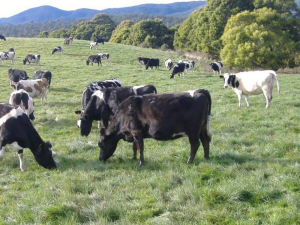Dairy sector profit still on the table, but margin gap tightens
DairyNZ’s latest Econ Tracker update shows most farms will still finish the season in a positive position, although the gap has narrowed compared with early season expectations.
 Farmers who set their budget to perform at a low milk price will find volatility much easier to manage.
Farmers who set their budget to perform at a low milk price will find volatility much easier to manage.
Dairy farmers Rachel and Kenneth Short say despite a potential increase in forecast milk price, they won’t be making any changes to their farm budget.
The couple are equity partners with Louis and Barbara Kuriger on a 440 cow, 168ha Taranaki farm run under a very simple, low input system which operates year-in, year-out with farm working expenses (FWE) of $1.90-$2.20/kgMS. Production for 2016/17 is expected to be 140,000kgMS.
“We’ve run the same financial budget since 2010. We never make changes to the budget – even at a high payout, our farm working expenses are identical to what they are this year,” says Rachel.
“This means when payout goes up or down, it affects our profit. The biggest impact at a low payout is in capital expenditure and debt reduction.”
Rachel and Kenneth have put a lot of energy into operating a low-cost pasture-based system which is sustainable at all milk prices.
“We run a fully self-contained farm (no grazing off or bought-in feed). We have been challenged about our system in the past but, having been through the crunch period we’ve had, it’s reaffirmed our belief that we’re doing the right thing.”
Southland farm owner Tim Driscoll agrees the increased milk price won’t change their approach to this season.
The 560 cow, 190ha farm operates under a strong pasture focus, with minimal inputs of PKE and some fodder beet to fill feed deficits. FWE are $3.40/kgMS.
“We have a complete focus on the bottom-line at the moment. When the payout dropped, any costs and farm expenses were questioned and last season we cut spending in some areas of feed, breeding and animal health,” says Tim. “And it hasn’t had any effect, there’s been very little impact without those inputs.”
Tim says the reduced milk price has been good for driving some efficiencies to improve profit and repay debt.
“At least now we know we can operate in a low-cost environment. Two years ago our long-term budget was based on a $6 payout, now we’re at $5/kg MS. And if we use that same low-cost structure, we can generate some reasonable cash surpluses.”
Tim says their pasture focus is paying off and early spring production is up 20% on last year.
He says it’s important to acknowledge the banks, which have been good to many farmers. “Now we need to be good to them and repay losses once we come into profit. We will be here in a low payout environment again and we will be more prepared for it.”
Farmers share their stories
The Short and Driscoll farms are two of 18 farmers nationwide who have opened up their books and shared their 2016/17 farm financials online via dairynz.co.nz/tactics.
DairyNZ extension general manager Andrew Reid says farmers who set their budget to perform at a low milk price will find volatility much easier to manage.
“Scaling back a farm system to meet reduced income is much harder than maintaining a consistently low cost of production.”
However, Andrew says there are lessons to be learned from low milk prices.
“We encourage farmers to continue their focus on pasture, set a system that will survive in a low or high milk price, stay financially disciplined and focus on repaying debt,” says Andrew.
“We are going from a deficit situation to farmers potentially being able to return to break-even and pay down some debt they might have accrued. It’s a good time to maintain low costs and recover some ground.”
Farmers are encouraged to prioritise catching up on essential repairs and maintenance, and capital fertiliser applications, with the major focus being on repaying suppliers and paying down debt.
To read the Short and Driscoll farm financials in more detail and listen to audio sharing how other top operators spend their money, visit dairynz.co.nz/tactics
Find out the top 10 attributes of farmers who have shared their budgets online, visit dairynz.co.nz/top10.
Tactics of top dairy farmers
- Routinely operate a farm system which performs at a low milk price.
- Focus on maximum pasture utilisation.
- Focus on profit, not production.
- Farm working expenses don’t change, despite milk price.
- Profit goes toward debt reduction.
The National Wild Goat Hunting Competition has removed 33,418 wild goats over the past three years.
New Zealand needs a new healthcare model to address rising rates of obesity in rural communities, with the current system leaving many patients unable to access effective treatment or long-term support, warn GPs.
Southland farmers are being urged to put safety first, following a spike in tip offs about risky handling of wind-damaged trees
Third-generation Ashburton dairy farmers TJ and Mark Stewart are no strangers to adapting and evolving.
When American retail giant Cosco came to audit Open Country Dairy’s new butter plant at the Waharoa site and give the green light to supply their American stores, they allowed themselves a week for the exercise.
Fonterra chair Peter McBride says the divestment of Mainland Group is their last significant asset sale and signals the end of structural changes.
President Donald Trump’s decision to impose tariffs on imports into the US is doing good things for global trade, according…
Seen a giant cheese roll rolling along Southland’s roads?